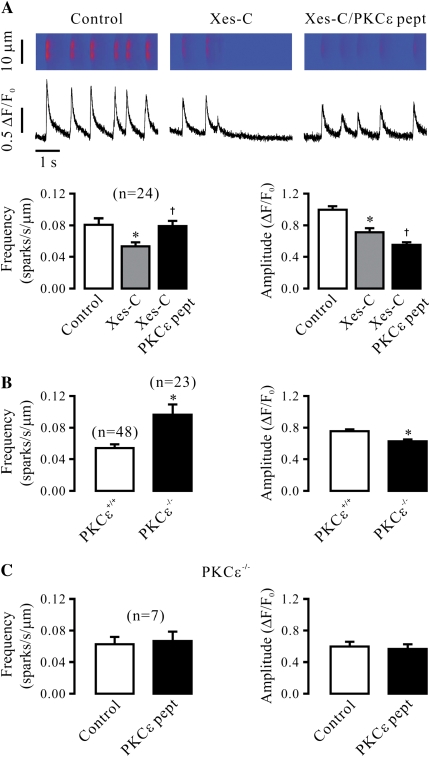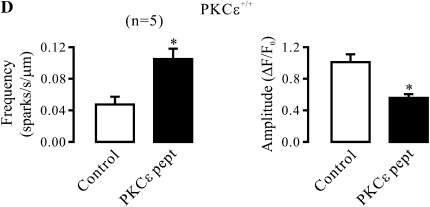Figure 1.
Specific inhibition of protein kinase C (PKC)-ɛ reduces Ca2+ spark activity in airway smooth muscle cells (SMCs) in the absence of functional inositol 1,4,5-triphosphate receptors (IP3Rs). (A) Effect of specific PKCɛ peptide inhibitor on Ca2+ sparks after treatment with xestospogin-C. Line-scanning images show Ca2+ sparks in a cell before control and after treatment with 10 μM xestospongin-C (xes-C) for 8 minutes to block IP3Rs as well as after application of specific PKCɛ peptide inhibitor (100 μM) for 8 minutes in the continued presence of xestospongin-C. Bar graphs summarize the effects of xestospongin-C and PKCɛ peptide inhibitor in the presence of xestospongin-C on the frequency and amplitude of Ca2+ sparks. Numbers in parentheses indicate the number of cells examined. (B) Effect of PKCɛ gene deletion on Ca2+ sparks after treatment with xestospogin-C. Quantification data show the mean frequency and amplitude of Ca2+ sparks in 48 PKCɛ+/+ and 23 PKCɛ−/− cells after treatment with xestospongin-C (10 μM) for 8 minutes. (C) Effect of PKCɛ peptide inhibitor (100 μM) on Ca2+ sparks in PKCɛ−/− cells after treatment with xestospogin-C (10 μM) for 8 minutes. (D) Effect of PKCɛ peptide inhibitor (100 μM) on Ca2+ sparks in PKCɛ+/+ cells after treatment with xestospogin-C (10 μM) for 8 minutes. Data are presented as means (±SEM). *P < 0.05 compared with control (before application of xestospongin-C or PKCɛ pept) or PKCɛ+/+; †P < 0.05 compared with after treatment with xestospongin-C.


